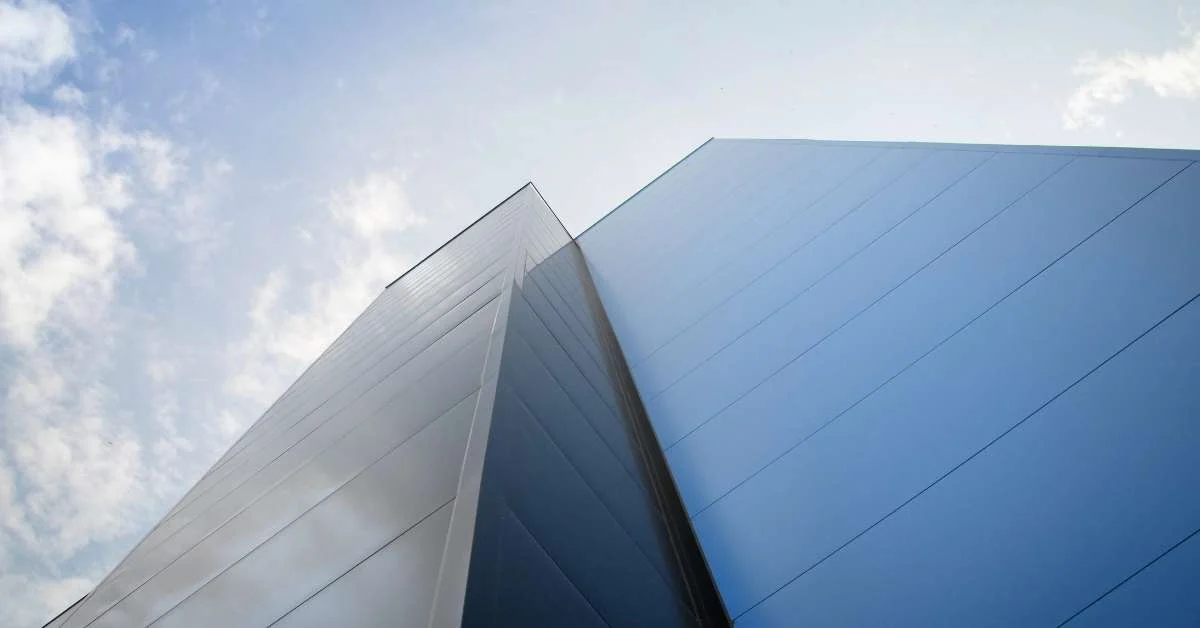ADDWIND is the innovation developed by Isopan for ventilated facades.
It belongs to the ADDMIRA range, and is a sub-category of it.
ADDMIRA is the range of innovations through which Isopan exports sandwich panels in new design contexts.
The sandwich panel is usually used in industrial construction, through ADDIMIRA this construction element is launched towards other sectors, in particular those relating to the facades of residential buildings or buildings intended for the service sector or to host public services.
In these areas, the range in question is greatly appreciated because it succeeds in uniting the functionality of the buildings with aesthetic harmony, in relation to the urban context that the building is inserted in.
In fact ADDMIRA is a solution that ensures:
- Versatility, as it can be adapted to any design requirement;
- Design, guaranteed by the broad range of aesthetic choices;
- Tailoring, understood as the ability to offer various customisations.
From a purely technical point of view, some product performance-related factors can be found in the ADDMIRA range of solutions These mostly concern:
- Thermal insulation: ensured by the insulating material of the sandwich panels. Whether they are made of polyurethane or rock mineral wool, they reduce the exchange of heat between the outdoor environment and indoor rooms to a minimum;
- Protection in case of fire: also in this case, it is the panel technology that makes the difference, thanks to its appreciable fireproof qualities;
- Eco-sustainability: ADDMIRA conforms to the needs of eco-sustainable construction through the use of the Leaf solution for sandwich panels.
Furthermore, this range, like all sub-products in the category, makes it easier to obtain LEED and BREEAM certifications.
Having described the traits shared with the ADDMIRA range, we can now move on to specifically analysing the peculiarities of ADDWIND.
ADDWIND solution, what are the benefits
Before analysing the benefits of this solution, it is useful to briefly go back to the concept of ventilated facades.
These represent a type of construction that is characterised by the presence of a ventilated chamber between the perimeter wall of the building and the external cladding, installed with a mechanical anchoring system.
In this construction sector, ADDWIND represents an innovative system capable of ensuring:
- Versatility;
- Function.
- Aesthetics
If the first is ensured by the broad range of customisations that allow you to fulfil multiple aesthetic needs, the second involves a series of benefits, such as:
- Energy saving: the ventilation of the facade promotes an increase in the insulating performance of the internal wall, with benefits on energy consumption;
- Durability: ADDWIND involves the use of materials that are resistant to the atmospheric agents and is able to maintain the technical and aesthetic characteristics of the facade unaltered over time;
- Shock-resistant: the elements used in this type of dry construction stand out for their capacity to withstand external mechanical shocks (such as impact, abrasion or acts of vandalism);
- Easy assembly: due to the fact that we are talking about a dry construction, which as such does not require the use of adhesives or cementitious mortars. This means that installation times are reduced, with positive effects on processing costs.
Another tax-related advantage must be added on top of all of this: this technology allows access to the Sisma Bonus (*earthquake incentive), the 110% Superbonus and the one for facades.
The ADDWIND structure
From a technological point of view, ADDWIND is composed of:
- Polyurethane (ISOCOP) or rock mineral wool (ISOFIRE ROOF) sandwich panels, which form the insulating layer applied to the perimeter wall of the building;
- ARKWALL brackets, which interface the insulating panels with the cladding and which, depending on the installation configuration, can be type 1.0 or type 2.0
- External cladding, available in a wide range of customisations.
The variety of available finishes not only allows satisfying the customer's taste but also provide aesthetic continuity to the context that the building is located in.
Fields of application of ADDWIND
Combining customisation and benefits, the ventilated facade designed by Isopan is suitable for installation in various fields of building; moreover, this system can be used not only for the construction of new buildings but for redevelopment, thanks to the fact that the solution in question is suitable for installation on various types of substructures.
The expansion of the scope of use is also ensured by the fact that the versatility of this solution concerns aesthetics as well, this aspect is guaranteed by the multiple types of finishes, thereby allowing designers and builders to use ADDWIND to meet customer needs.
ADDWIND, aesthetic versatility and customisation of the claddings
What makes customisation of the claddings possible is an articulated range of choices regarding the external layer of the cladding, which can be customised thanks to both the diversity of proposed materials and the aesthetic aspects that can be achieved.
In detail, it is possible to choose from these types of claddings:
IN-HPL (high pressure laminate)
In this case, the panel is composed of thermosetting resins (30%) and pressed cellulose fibres (70%).
The use of polyurethane-based pigmented resins makes the surface compact and decorative.
The non-porous HPL skin is easy to wash and resistant to mechanical shocks, atmospheric agents and chemicals.
IN-ROCK
Basaltic rock fibre characterises this panel, reinforced by a thermosetting synthetic intermediate layer.
The decorative surface is multi-thickness, consisting of three layers of acrylic primer and one of acrylic colour The ProtectPlus protective film can be added on request.
The treatment that this skin is subjected to ensures that it offers excellent standards of resistance to UV rays and adverse weather.
IN-COMPO
This cladding consists of an aluminium panel painted with PVDF technology.
IN-COMPO guarantees a uniform surface, easy to install, and long lasting. Additionally, it is resistant to corrosion, aging and sunlight.
The wide availability of colours and finishes makes it adaptable to any context.
LG-DRILL
Where the cladding is made up of ISOPAN - LG 28 corrugated sheets in pre-painted galvanised steel.
The surface of the metal sheet can be:
- Without micro-perforation;
- With partial micro-perforation;
- With total micro-perforation.
LP - STRETCH
This skin is composed of expanded sheet metal. The sheet metal mesh is designed by expanding and cutting the material.
LP - STRETCH is a cladding often used for defence and protection, as well as in the field of decorative architecture.
LP - DRILL
Cladding characterised by perforated aluminium or steel sheets. Varia is the range of available perforations, for example:
- Round
- Square
- Hexagonal
- Custom;
Just as the thicknesses and finishes are different (galvanised, rolled, hot and/or cold, aisi 316, aisi 304), offering various aesthetic solutions.
GRES
This is a skin made up of ceramic slabs. Laminated porcelain creates compact surfaces, and the employed technology ensures resistance against mechanical shocks and the action of atmospheric and chemical agents.
Available in multiple thicknesses and sizes, stoneware provides hygienic and fire-resistant cladding.
DEKTON
A technological material composed of porcelain, glass and quartz. High strength and versatility for home applications and large projects.
The material has numerous features such as resistance to UV rays, low and high temperatures, or contact with water.
WPC
In this case, a polymer alloy consisting of PVC and wood (from forests managed according to environmental standards) is used.
The result is a chemical wood appreciated for its aesthetics but also for its long-term reliability. Furthermore, unlike natural wood, WPC does not require frequent maintenance work.
A - CONCRETE
This cladding is characterised by the use of ecological fibre cement panels.
They can be arranged vertically or horizontally, as well as "interlocking"
In addition, they can be processed to create different modules, which makes this skin suitable for use in a multitude of projects.
TERRACOTTA
Terracotta elements obtained from natural clays which offer special characteristics in terms of colour, resistance, strength and porosity.
Available in a great variety of elements, these are the characteristics of the clay: the mouldability and the progressive customisation of the production in terms of design of the terracotta elements.
ISOBRICK
Composed of clay bricks attached to metal elements with non-slip tiles.
With this type of cladding, the beauty of brick is associated with easy installation and the benefits of a ventilated facade.
The Isobrick cladding is available in a wide range of sizes and colours, and is therefore able to meet multiple design needs.
These skins can also be used in combination with the ISOLED system, making it possible to create lighting effects that enhance the aesthetic value of the building at night.
ADDWind, case history
Having analysed the characteristics of the ventilated facade system created by Isopan, it would be interesting to verify the benefits in terms of its concrete application. Accordingly, it might be useful to mention two examples.
The first is a nursery school in Massa Carrara, where the ventilated façade was HPL with mineral wool panels, suitable for ensuring the comfort of the school staff and children.
Using this solution meant completing the work in a short amount of time, which made it possible to meet the needs of the school’s organisation.
Additionally, the use of the "Individual" technique made it possible to customise the facade of the building, in this specific case embellished by the work of a local artist.
The second example is a spa hotel in Padua. Different needs, different context, but the same goals have been achieved.
Also in this case it was in fact possible to work quickly so as not to obstruct the preparatory work to begin welcoming guests.
Therefore, both cases allow us to clarify the concrete benefits of choosing ADDWIND.
A solution that not only guarantees customisation, safety and living comfort, but also rapid installationnecessary for the containment of construction times and costs.


